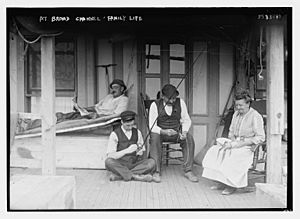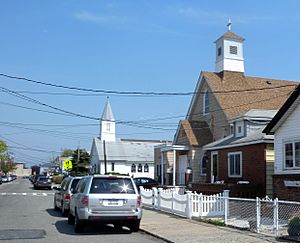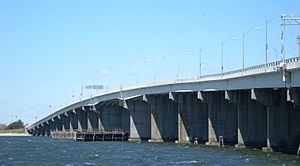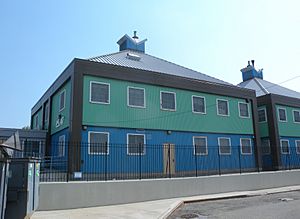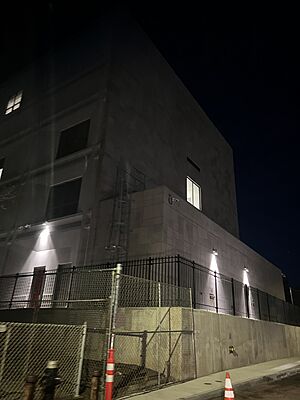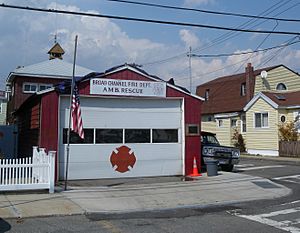Broad Channel, Queens facts for kids
Quick facts for kids
Broad Channel
|
|
|---|---|
|
Neighborhood of Queens
|
|
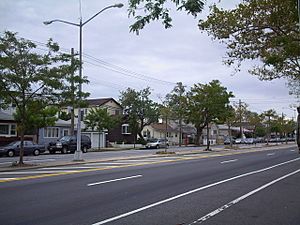
Cross Bay Boulevard
|
|
| Country | |
| State | |
| City | |
| County/Borough | |
| Community District | Queens 14 |
| Population | |
| • Total | 3,000 |
| Time zone | UTC−5 (EST) |
| • Summer (DST) | UTC−4 (EDT) |
| ZIP Code |
11693
|
| Area codes | 718, 347, 929, and 917 |
Broad Channel is a neighborhood in Queens, a part of New York City. It's on the southern part of an island called Rulers Bar Hassock, also known as "Broad Channel Island." This is the only island in Jamaica Bay where people live.
The neighborhood was built on an area of land called Big Egg Marsh. It's about 20 blocks long and 4 blocks wide. Broad Channel is located inside the Jamaica Bay Wildlife Refuge. This refuge is managed by the U.S. National Park Service. It's part of the Gateway National Recreation Area.
The area has many man-made canals. These canals separate the streets where people live. Broad Channel is connected to the rest of Queens by bridges for cars and subways.
Broad Channel is in Queens Community District 14. Its ZIP Code is 11693. The New York City Police Department's 100th Precinct patrols the area.
Contents
History of Broad Channel
Early Days
Before Europeans arrived, Lenape Native Americans, like the Jameco and Canarsie groups, often visited this area. In the 1600s, Dutch settlers built a community on the island. They started collecting oysters, clams, shrimp, and fish. The name "Broad Channel" first referred to a water channel in Jamaica Bay.

Before the American Civil War, most islands in Jamaica Bay were not lived on. This included Broad Channel. The island was mostly part of the town of Jamaica. After 1865, fishing businesses grew in the bay. By the late 1870s, buildings were being put up without permission.
The Long Island Rail Road built its Rockaway Beach Branch across the bay in 1880. This railroad line went right through Broad Channel. The railroad helped fishing villages grow. These villages had small shacks, summer homes, and stores.
Broad Channel stayed part of the town of Jamaica until New York City became much larger in 1898. The northern part of the island is now part of Gateway National Recreation Area. It is managed as part of the Jamaica Bay Wildlife Refuge. This is the only wildlife refuge managed by the National Park Service. The community is surrounded by the waters and marsh islands of the refuge.
The 1900s
In 1915, the city leased Broad Channel Island to a company called Broad Channel Corporation. This lease was for 30 years. The company then rented out smaller parts of the land to people. These people built summer bungalows and houses.
People criticized the deal because the rent seemed too low. The Broad Channel Corporation said they had made many improvements. They dug a well for drinking water and built a power plant. They also added land to reduce the need for houses on stilts. Streets were also laid out on the island.
However, residents said the improvements were not good enough. They said the tap water was brown and not safe to drink. Many houses had no electricity, and there were no sewers. The company said the water was like water in other areas. They planned to filter the water. They also said streets had electric lights. They claimed sewers were not possible on the island.
For many years, you could only reach the island by ferry or train. But in 1925, the North Channel Bridge opened. This bridge connected the island to Howard Beach. The Cross Bay Parkway Bridge also opened in 1925. This bridge connected Broad Channel to the Rockaways.
The railroad bridge across Jamaica Bay had about 30 fires between 1942 and 1950. One fire in 1950 stopped train service. The railroad company was bankrupt and could not fix the bridge. So, New York City bought the line in 1952. It reopened in 1956 as part of the New York City Subway.
In 1938, Parks Commissioner Robert Moses wanted to build a park on the island. He planned a recreation area on the shore. A wildlife sanctuary would be on the north end. In 1939, the Broad Channel Corporation went bankrupt. The city then took ownership of the island's land.
In 1944, Broad Channel's 4,000 residents lived in 1,260 homes. They got a court order to stop the city from making them leave. Later in 1944, the city said residents could buy the land under their homes. But this right was delayed for many years. The city tried to change the island's use many times. But the local community always fought against these plans. Some ideas included building a large port or extending John F. Kennedy International Airport.
In 1967, there were rumors of health problems due to the island's bad sewage system. Some homes still dumped sewage into the bay. This led to bans on clamming, wading, and swimming. The health risks made the city try to evict residents again. Residents protested, and the city decided to renew their leases. Finally, in 1982, New York City allowed Broad Channel residents to buy their property. The Joseph P. Addabbo Memorial Bridge replaced the old North Channel Bridge in 1993.
The 2000s
In August 2011, Broad Channel had its first required evacuation. This was because of Hurricane Irene. After the storm, two homes collapsed into Jamaica Bay. This was due to the high storm tide. In October 2012, Broad Channel had another required evacuation for Hurricane Sandy. The storm caused a lot of damage. Most homes were flooded. There were also long power cuts and shortages of food and water.
News reports said that high tides sometimes flooded parts of the neighborhood. The city suggested raising streets and sidewalks by three feet. New sea walls were also being built. These efforts help stop street flooding. Broad Channel is still one of the New York City neighborhoods most likely to flood. It has had the most repeated flood-related insurance claims.
People of Broad Channel
In 2010, about 3,000 people lived on Broad Channel island. Many residents work as civil servants or emergency workers. A 2015 study showed that about 47% of adults who grew up in Broad Channel still lived there. This is a very high number compared to other neighborhoods in the city.
Getting Around Broad Channel
Public Transportation
The New York City Subway's IND Rockaway Line (A and S train) has a station in Broad Channel. The Q52, Q53 Select Bus Service routes also serve Broad Channel. The QM16, QM17 express buses run along Cross Bay Boulevard.
Street Names
Broad Channel has its own special way of naming streets. Streets have "East" and "West" in their names. This depends on which side of Cross Bay Boulevard they are on. Roads are numbered from north to south. This naming system is different from other parts of Queens. It makes sure there are no duplicate street names.
Bridges
Broad Channel is connected to the rest of Queens by four bridges. The Cross Bay Veterans Memorial Bridge is to the south. It has a toll for cars. The Joseph P. Addabbo Memorial Bridge is to the north and is free. There are also two subway bridges.
Cross Bay Boulevard is the island's only main road. It goes over both car bridges. You can also walk or bike on these bridges. Broad Channel is located between Howard Beach and the Rockaway Peninsula. These bridges connect it to those communities.
After the Cross Bay Parkway bridge was built in 1939, it was easier to reach the island by car. This bridge replaced an older, narrow one from 1925. However, the bridge was a drawbridge and opened often for boats. This caused long traffic jams.
A new bridge was built in the 1960s. It opened on May 28, 1970. In 1977, it was renamed the Cross Bay Veterans Memorial Bridge. MTA Bridges and Tunnels maintains it. There is a toll to use this bridge.
The Joseph P. Addabbo Memorial Bridge connects Broad Channel to Howard Beach. It opened in 1993. It used to be called the North Channel Bridge. It replaced an old bridge from 1925 that was falling apart. The New York City Department of Transportation maintains this bridge, and it is free.
Schools and Library
Schools
The New York City Department of Education serves Broad Channel. Elementary school students go to PS 47. This school teaches students from pre-kindergarten to eighth grade. The school buildings were completely updated in the 1990s. In the 2023-2024 school year, PS 47 reopened in a new building after two years of construction.
Broad Channel also had St. Virgilius School. This was a Roman Catholic school. But it closed in 2006 after a long discussion. Two years later, St. Virgilius Parish joined with St. Camillus Parish.
Library
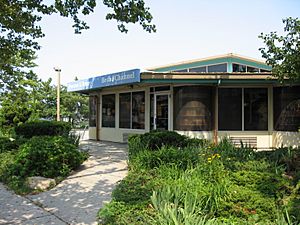
The Queens Public Library has a branch in Broad Channel. It is located at 16-26 Cross Bay Boulevard.
Community Groups
Broad Channel Athletic Club
The Broad Channel Athletic Club is a non-profit group. It started in 1961. They have baseball teams registered with Little League. They also have an in-house baseball league. Their teams play in the Catholic Youth Organization. The football league plays in the Nassau and Suffolk Football League. The soccer league is run by the club. It also plays in the Catholic Youth Organization. They have swimming and basketball teams too.
Broad Channel Historical Society
The Broad Channel Historical Society started in 1994. It was created after someone read a local newsletter column about the past. Ada L. Smith, a New York State Senator, gave funds to the society. They used the money to buy notebooks to record the community's history. Since 1995, the society has held an Annual Historical Day. Visitors can see their collection at the Broad Channel Library.
The library is home to the historical collection. The collection was put on microfilm in 1997. You can view the microfilm at the Central Branch in Jamaica, Queens. Also in 1997, the first Historical Calendar was published. These calendars show old pictures of Broad Channel and tide information.
Broad Channel Volunteer Fire Department
The fire department began in 1905 as a bucket brigade. This group helped reduce damage from fires. In 1907, it became the Broad Channel Volunteer Fire Association. Their first Chief was Edward H. Schleuter. The current firehouse opened in 1908. In 1913, Chief Chris Hoobs died while responding to a fire. The association received its official charter in 1917. They were then known as the Broad Channel Volunteers.
In 1956, Robert H. Russell Sr. added volunteer ambulance services. This provided first aid to residents. He was elected Chief of Department many times. By the early 1960s, the department was growing fast.
On summer weekends in the 1950s and 1960s, the FDNY (New York City Fire Department) would send a spare engine. This engine, called Engine Company No. 341, helped the volunteers. The bridges on the island were drawbridges. They often opened for large ships. This would block traffic and make it hard for FDNY to respond. Sometimes, the bridge would get stuck open.
Also, Cross Bay Boulevard would be very crowded with beachgoers. Often, FDNY firefighters would leave their large trucks. They would join the volunteers on their smaller trucks. These smaller trucks could get through the narrow streets.
Over the years, the Broad Channel Volunteers have worked closely with the FDNY. They also work with volunteer companies from other counties. The Broad Channel Volunteers are members of many organizations. These include the Southern New York Volunteer Firemans Association. They are also members of the Firemans Association of the State of New York.
In the late 1970s, the Broad Channel Junior Fire Department was started. This group trained young teens in fire and EMS services. They also learned dispatching and office duties. When members turned 18, they could become firefighters or EMTs. This group helped train future firefighters and officers. They later became a Boy Scout Explorer Post.
In 1994, the volunteer ambulance corps became New York State Certified. Since then, all firefighters must be certified in fire service and EMS. In 1994, the department also started its Marine Company. This team operates a small boat for swift water rescue. It has certified EMTs and sometimes divers.
In 2012, Hurricane Sandy caused a lot of damage. The fire department lost its fire trucks and ambulances. A replacement fire truck was loaned from Chanhassen, Minnesota. Other Minnesota towns also sent help. They sent boots, helmets, air monitors, and other equipment.
The Broad Channel Volunteers, Inc., is a non-profit organization. It relies on donations and grants. Since 1905, it has been run by 100% volunteers.
Parks and Playgrounds
Sunset Cove Park
Sunset Cove Park opened on August 21, 2019. It is on 12.57 acres of land. This land used to be a marina. Workers removed a lot of debris and polluted soil. They restored a 4.5-acre salt marsh and a 7-acre upland area. A walkway and a shoreline barrier were also built. About 16,000 tons of sand were brought in. Future plans include an oyster garden, a dock, and a boardwalk.
Broad Channel American Park
Broad Channel American Park opened in May 1995. It is at the very south end of Broad Channel. It sits along Jamaica Bay. The park has two grass baseball fields and one asphalt baseball field. It also has benches, water fountains, and a parking area. There are four basketball hoops and a small play area. The flagpole area has a nautical theme. The park got its current name in March 1998.
Broad Channel Park
Broad Channel Park is also known as 17th Road Playground. It is on Cross Bay Boulevard. It stretches between 16th and 18th Roads. This park has a hockey rink, basketball courts, and handball courts. It also has playgrounds and tennis courts.
Gene Gray Playground
Gene Gray Playground is at Cross Bay Boulevard and East 9th Road. It is named after Eugene Gray (1927–1973). He was a community activist. He supported building the island's first adventure playground. In 1987, the community successfully asked to rename the playground after Gray. The playground cost $457,688. It opened on November 12, 1987. It was designed by Richard Dattner. The wooden play structures look like a nautical fortress. There is also a 75-year-old willow tree. Nine red maple trees and ninety burning bushes surround the playground.


